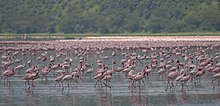Lake Nakuru
| Nakuru lake | ||
|---|---|---|

|
||
| Geographical location |
East Africa , Kenya |
|
| Tributaries | Njoro , Nderit , Makalia , Lamudhiak | |
| Drain | no | |
| Places on the shore | Nakuru | |
| Data | ||
| Coordinates | 0 ° 22 ′ 0 ″ S , 36 ° 5 ′ 0 ″ E | |
|
|
||
| Altitude above sea level | 1760 m | |
| surface | 40 km² | |
| Maximum depth | 4.5 m | |
| Middle deep | 2.3 m | |
|
particularities |
Soda Lake, famous for flamingos |
|
The Lake Nakuru (English: Lake Nakuru ) lies in Lake Nakuru National Park in Kenya and is known worldwide as a unique natural spectacle. The up to four meters deep drainless lake, one of the alkaline soda lakes in the eastern East African rift valley , the Rift Valley , is world famous for its numerous flamingos . The sometimes up to two million flamingos feed on blue-green algae ( spirulina ) or small crustaceans, which is what gives the actually white animals their pink color. A pink band can be seen from afar, which usually runs around the entire lake on the lake shore. When there is a lack of food, the flamingos move to one of the other soda lakes such as Lake Bogoria or Lake Elmenteita .
The lake belongs since 2011 as part of the " Kenyan lakes system in the Great Rift Valley " for UNESCO - World Heritage .
geography
The lake is located in the eastern part of the East African Rift Valley ( Great Rift Valley ). The lake basin is bounded in the north by the Menengai caldera , in the south by the volcano Mount Eburru , in the west by the ridge edge of the Mau escarpment and in the east by the Kinangop plateau and the Aberdare volcanic complex ( Aberdare Range ). The 1800 km² catchment area has little rain, which is why the hydrological budget of the basin is extremely negative and the lake with no runoff is highly alkaline.
The lake is entirely in Nakuru County in Kenya , about 140 km northwest of the capital Nairobi .
etymology
The prefix "Na" means "place". "Kuru" is the name for "waterbuck" in the languages of the nearby tribes (AB Sydserif, the longest living resident of Nakuru, personal interview April 1958). So “Nakuru” possibly means “the place of the waterbuck”. “The place where the cows don't eat” is another definition (“The story of Nakuru from the beginning”, EAS, Nov. 28, 1952). This would reflect a mineral poor soil west of the city.
“Nakurro”, pronounced with a trilled “r”, means “the dusty place”, “the place of displacement”, “the place of smoke” (District Commissioner, Narok). “The place of the dust devils” is another definition (“Clouds Over Nakuru”, EAS, July 21, 1953).
Flora and fauna
In 1960 two small species of cichlids from the genus Alcolapia were released to control mosquitoes ( A. alcalica and A. grahami ). These perches are edible fish that can survive in an alkaline environment. The tilapia have reproduced so much that they attract fish-eating birds: herons , pelicans and cormorants . The lake is home to around 450 species of birds, mostly flamingos and pelicans. In some years up to a million Lesser Flamingos have been counted on Lake Nakuru. The surrounding Nakuru National Park has a rich wildlife with rhinos , giraffes and antelopes . Around 550 species of plants grow on the lake.
environment
The lake is entirely in the Lake Nakuru National Park . It is increasingly threatened by siltation (but also by pollution) during drought, and the entire community around the unique bird world begins to suffer from this. On the northern shore of the lake is the city of Nakuru , with about 300,000 inhabitants (2000) the fourth largest city in Kenya. The extraction of water from the tributaries of Lake Nakuru (Njoro, Makalia, Nderit), the cutting down of the Mau forest and the discharge of sewage pose severe threats to the environment commercial mining of sand at the tributaries of the lake. The lake received only one (also threatened) inflow from the Baharini river. The vast majority of the flamingos that are no longer able to breed have already emigrated, preferably to Lake Naivasha and Lake Baringo .
The levels of Lake Nakuru and Lake Naivasha have risen significantly in recent years due to abundant rainfall (as of January 2019). The riparian forests consisting of old trees drowned in the process; both lakes are surrounded by a belt of dead trees. The building of the former main entrance to Nakuru National Park is now in the water. On the one hand, the increase meant that the lake is now too deep for the flamingos, they have relocated to Tanzania. On the other hand, fish stocks have increased significantly, to the delight of fishermen, cormorants, ospreys and pelicans.
Web links
- LakeNet: Nakuru. On: worldlakes.org. Information about Lake Nakuru (English).
- Kenya Wildlife Service: Lake Nakuru National Park. On: kws.go.ke. English.
Individual evidence
- ↑ Entry on the website of the UNESCO World Heritage Center ( English and French ).
- ↑ https://archive.org/stream/cbarchive_101865_meaningofthenamenakuru1960/XXIII_No.7__104__303_1960_Kirby_djvu.txt , accessed on September 19, 2019


